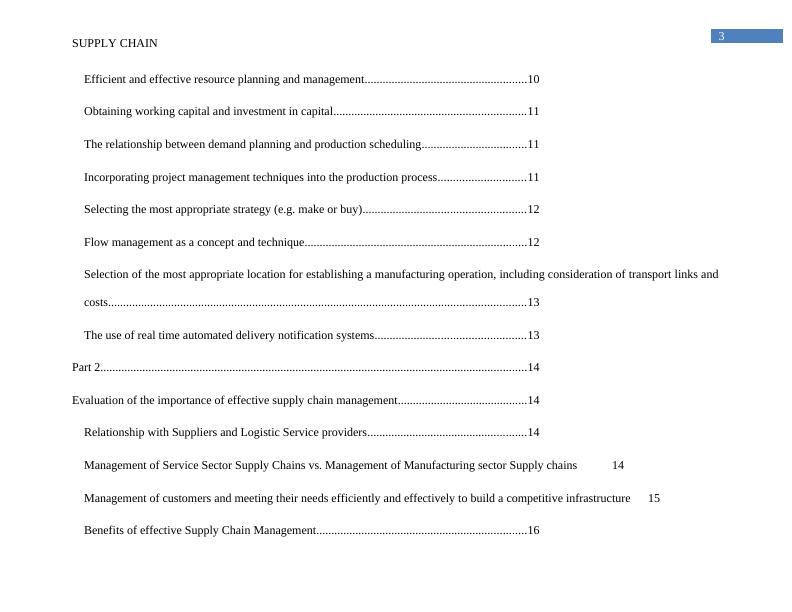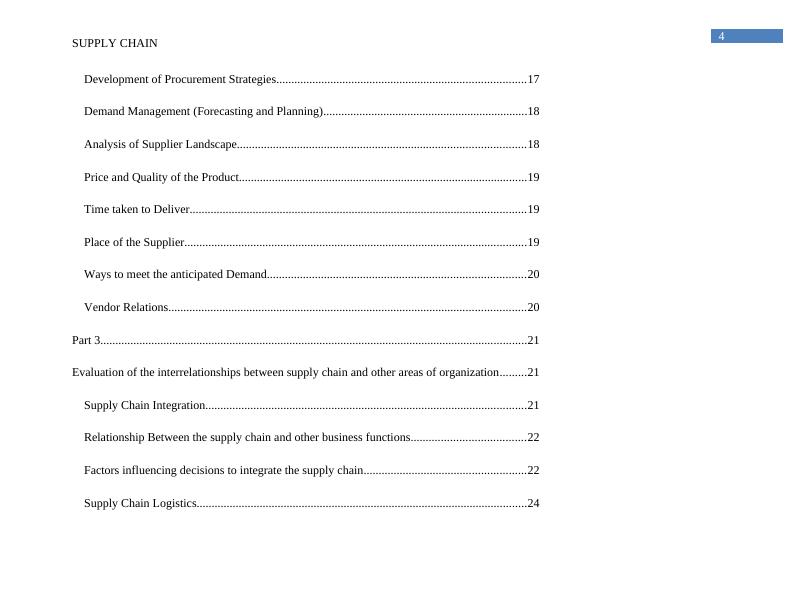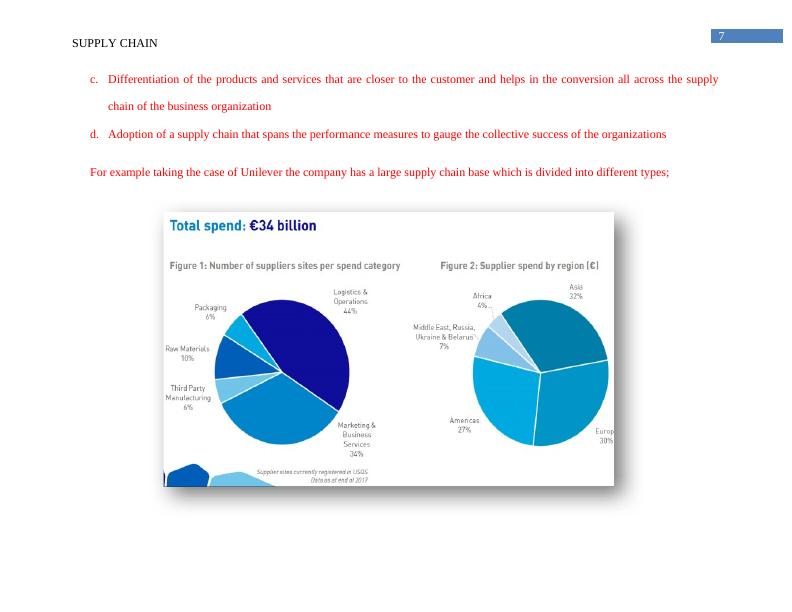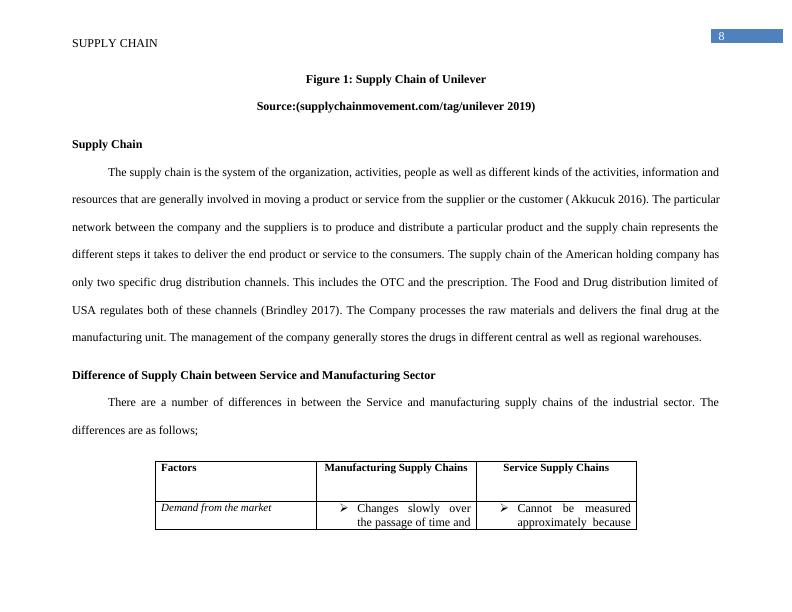Application of Key Supply Chain Concepts, Principles and Processes
Advice Boots UK on supply chain management and complete a consultant management report for the senior management team of Walgreen Boots Alliance.
43 Pages9383 Words189 Views
Added on 2023-04-21
About This Document
This study material discusses the application of key supply chain concepts, principles, and processes. It explores the difference between service and manufacturing supply chains and the principles of supply chain management. It also covers topics such as efficient resource planning, obtaining working capital, demand planning, and production scheduling.
Application of Key Supply Chain Concepts, Principles and Processes
Advice Boots UK on supply chain management and complete a consultant management report for the senior management team of Walgreen Boots Alliance.
Added on 2023-04-21
ShareRelated Documents
Running head: SUPPLY CHAIN
Supply chain
Name of the student
Name of the university
Supply chain
Name of the student
Name of the university

2
SUPPLY CHAIN
Author Note:
Table of Contents
Introduction......................................................................................................................................5
Part 1................................................................................................................................................5
Application of Key Supply Chain Concepts, Principles and Processes..........................................5
Supply Chain...............................................................................................................................6
Difference of Supply Chain between Service and Manufacturing Sector...................................7
Supply Chain Management..........................................................................................................7
The key principles of supply chain management........................................................................8
Use of lean supply chain principles to enhance competitive advantage......................................9
SUPPLY CHAIN
Author Note:
Table of Contents
Introduction......................................................................................................................................5
Part 1................................................................................................................................................5
Application of Key Supply Chain Concepts, Principles and Processes..........................................5
Supply Chain...............................................................................................................................6
Difference of Supply Chain between Service and Manufacturing Sector...................................7
Supply Chain Management..........................................................................................................7
The key principles of supply chain management........................................................................8
Use of lean supply chain principles to enhance competitive advantage......................................9

3
SUPPLY CHAIN
Efficient and effective resource planning and management......................................................10
Obtaining working capital and investment in capital................................................................11
The relationship between demand planning and production scheduling...................................11
Incorporating project management techniques into the production process.............................11
Selecting the most appropriate strategy (e.g. make or buy)......................................................12
Flow management as a concept and technique..........................................................................12
Selection of the most appropriate location for establishing a manufacturing operation, including consideration of transport links and
costs...........................................................................................................................................13
The use of real time automated delivery notification systems..................................................13
Part 2..............................................................................................................................................14
Evaluation of the importance of effective supply chain management...........................................14
Relationship with Suppliers and Logistic Service providers.....................................................14
Management of Service Sector Supply Chains vs. Management of Manufacturing sector Supply chains 14
Management of customers and meeting their needs efficiently and effectively to build a competitive infrastructure 15
Benefits of effective Supply Chain Management......................................................................16
SUPPLY CHAIN
Efficient and effective resource planning and management......................................................10
Obtaining working capital and investment in capital................................................................11
The relationship between demand planning and production scheduling...................................11
Incorporating project management techniques into the production process.............................11
Selecting the most appropriate strategy (e.g. make or buy)......................................................12
Flow management as a concept and technique..........................................................................12
Selection of the most appropriate location for establishing a manufacturing operation, including consideration of transport links and
costs...........................................................................................................................................13
The use of real time automated delivery notification systems..................................................13
Part 2..............................................................................................................................................14
Evaluation of the importance of effective supply chain management...........................................14
Relationship with Suppliers and Logistic Service providers.....................................................14
Management of Service Sector Supply Chains vs. Management of Manufacturing sector Supply chains 14
Management of customers and meeting their needs efficiently and effectively to build a competitive infrastructure 15
Benefits of effective Supply Chain Management......................................................................16

4
SUPPLY CHAIN
Development of Procurement Strategies...................................................................................17
Demand Management (Forecasting and Planning)....................................................................18
Analysis of Supplier Landscape................................................................................................18
Price and Quality of the Product................................................................................................19
Time taken to Deliver................................................................................................................19
Place of the Supplier..................................................................................................................19
Ways to meet the anticipated Demand......................................................................................20
Vendor Relations.......................................................................................................................20
Part 3..............................................................................................................................................21
Evaluation of the interrelationships between supply chain and other areas of organization.........21
Supply Chain Integration...........................................................................................................21
Relationship Between the supply chain and other business functions......................................22
Factors influencing decisions to integrate the supply chain......................................................22
Supply Chain Logistics..............................................................................................................24
SUPPLY CHAIN
Development of Procurement Strategies...................................................................................17
Demand Management (Forecasting and Planning)....................................................................18
Analysis of Supplier Landscape................................................................................................18
Price and Quality of the Product................................................................................................19
Time taken to Deliver................................................................................................................19
Place of the Supplier..................................................................................................................19
Ways to meet the anticipated Demand......................................................................................20
Vendor Relations.......................................................................................................................20
Part 3..............................................................................................................................................21
Evaluation of the interrelationships between supply chain and other areas of organization.........21
Supply Chain Integration...........................................................................................................21
Relationship Between the supply chain and other business functions......................................22
Factors influencing decisions to integrate the supply chain......................................................22
Supply Chain Logistics..............................................................................................................24

5
SUPPLY CHAIN
Customization of Logistics Network to meet service requirements..........................................24
Customer Demand Planning and Product Life Cycle................................................................25
Holistic Approach to managing and Optimizing the effectiveness of supply Chain.................26
Balancing inventory...................................................................................................................26
Virtual supply chain modeling...................................................................................................27
Use of SCOR Model..................................................................................................................27
Recommendation for improvements to a supply chain strategy for an organization................29
1. Automatic Purchasing............................................................................................................29
Gain Data Insight.......................................................................................................................30
Real-Time Inventory Management............................................................................................31
Monitor Vendor Performance....................................................................................................31
Raise Cost Awareness................................................................................................................31
Improve Returns Management..................................................................................................31
Just-in-time (JIT).......................................................................................................................31
SUPPLY CHAIN
Customization of Logistics Network to meet service requirements..........................................24
Customer Demand Planning and Product Life Cycle................................................................25
Holistic Approach to managing and Optimizing the effectiveness of supply Chain.................26
Balancing inventory...................................................................................................................26
Virtual supply chain modeling...................................................................................................27
Use of SCOR Model..................................................................................................................27
Recommendation for improvements to a supply chain strategy for an organization................29
1. Automatic Purchasing............................................................................................................29
Gain Data Insight.......................................................................................................................30
Real-Time Inventory Management............................................................................................31
Monitor Vendor Performance....................................................................................................31
Raise Cost Awareness................................................................................................................31
Improve Returns Management..................................................................................................31
Just-in-time (JIT).......................................................................................................................31

6
SUPPLY CHAIN
Streamline Accounting..............................................................................................................32
Timeline.....................................................................................................................................32
Table 1: Timeline of the Supply Chain Action Plan..................................................................33
Figure 1: Gantt chart..................................................................................................................33
References......................................................................................................................................34
Introduction
Part 1
Application of Key Supply Chain Concepts, Principles and Processes
The application of key supply chain concept is one of the most important concerns of the management of the business
organization. The supply chain concepts are linked with the strategies of the business by following a number of steps. This includes;
a. Segmentation of the customers based on the service needs of distinct groups and the adaption of the supply chains that will be
utilized to serve the following segments.
b. Customization of the logistics network to the service requirements and ensuring the profitability of the customer segments.
SUPPLY CHAIN
Streamline Accounting..............................................................................................................32
Timeline.....................................................................................................................................32
Table 1: Timeline of the Supply Chain Action Plan..................................................................33
Figure 1: Gantt chart..................................................................................................................33
References......................................................................................................................................34
Introduction
Part 1
Application of Key Supply Chain Concepts, Principles and Processes
The application of key supply chain concept is one of the most important concerns of the management of the business
organization. The supply chain concepts are linked with the strategies of the business by following a number of steps. This includes;
a. Segmentation of the customers based on the service needs of distinct groups and the adaption of the supply chains that will be
utilized to serve the following segments.
b. Customization of the logistics network to the service requirements and ensuring the profitability of the customer segments.

7
SUPPLY CHAIN
c. Differentiation of the products and services that are closer to the customer and helps in the conversion all across the supply
chain of the business organization
d. Adoption of a supply chain that spans the performance measures to gauge the collective success of the organizations
For example taking the case of Unilever the company has a large supply chain base which is divided into different types;
SUPPLY CHAIN
c. Differentiation of the products and services that are closer to the customer and helps in the conversion all across the supply
chain of the business organization
d. Adoption of a supply chain that spans the performance measures to gauge the collective success of the organizations
For example taking the case of Unilever the company has a large supply chain base which is divided into different types;

8
SUPPLY CHAIN
Figure 1: Supply Chain of Unilever
Source:(supplychainmovement.com/tag/unilever 2019)
Supply Chain
The supply chain is the system of the organization, activities, people as well as different kinds of the activities, information and
resources that are generally involved in moving a product or service from the supplier or the customer (Akkucuk 2016). The particular
network between the company and the suppliers is to produce and distribute a particular product and the supply chain represents the
different steps it takes to deliver the end product or service to the consumers. The supply chain of the American holding company has
only two specific drug distribution channels. This includes the OTC and the prescription. The Food and Drug distribution limited of
USA regulates both of these channels (Brindley 2017). The Company processes the raw materials and delivers the final drug at the
manufacturing unit. The management of the company generally stores the drugs in different central as well as regional warehouses.
Difference of Supply Chain between Service and Manufacturing Sector
There are a number of differences in between the Service and manufacturing supply chains of the industrial sector. The
differences are as follows;
Factors Manufacturing Supply Chains Service Supply Chains
Demand from the market Changes slowly over
the passage of time and
Cannot be measured
approximately because
SUPPLY CHAIN
Figure 1: Supply Chain of Unilever
Source:(supplychainmovement.com/tag/unilever 2019)
Supply Chain
The supply chain is the system of the organization, activities, people as well as different kinds of the activities, information and
resources that are generally involved in moving a product or service from the supplier or the customer (Akkucuk 2016). The particular
network between the company and the suppliers is to produce and distribute a particular product and the supply chain represents the
different steps it takes to deliver the end product or service to the consumers. The supply chain of the American holding company has
only two specific drug distribution channels. This includes the OTC and the prescription. The Food and Drug distribution limited of
USA regulates both of these channels (Brindley 2017). The Company processes the raw materials and delivers the final drug at the
manufacturing unit. The management of the company generally stores the drugs in different central as well as regional warehouses.
Difference of Supply Chain between Service and Manufacturing Sector
There are a number of differences in between the Service and manufacturing supply chains of the industrial sector. The
differences are as follows;
Factors Manufacturing Supply Chains Service Supply Chains
Demand from the market Changes slowly over
the passage of time and
Cannot be measured
approximately because

End of preview
Want to access all the pages? Upload your documents or become a member.
Related Documents
Erin Networks (GIP) - Business Plan for 5G Networklg...
|50
|11934
|383
CEMEX: An In-Depth Situational Analysis and Strategic Planlg...
|40
|10585
|211
TechReturn Platform Business Planlg...
|51
|19169
|453
Global Business Management Capstone (BUS8350)lg...
|41
|10624
|166
Business Analysis of Air Traffic Navigation Systemslg...
|37
|4921
|410
Develop a Sales Planlg...
|49
|11258
|311
